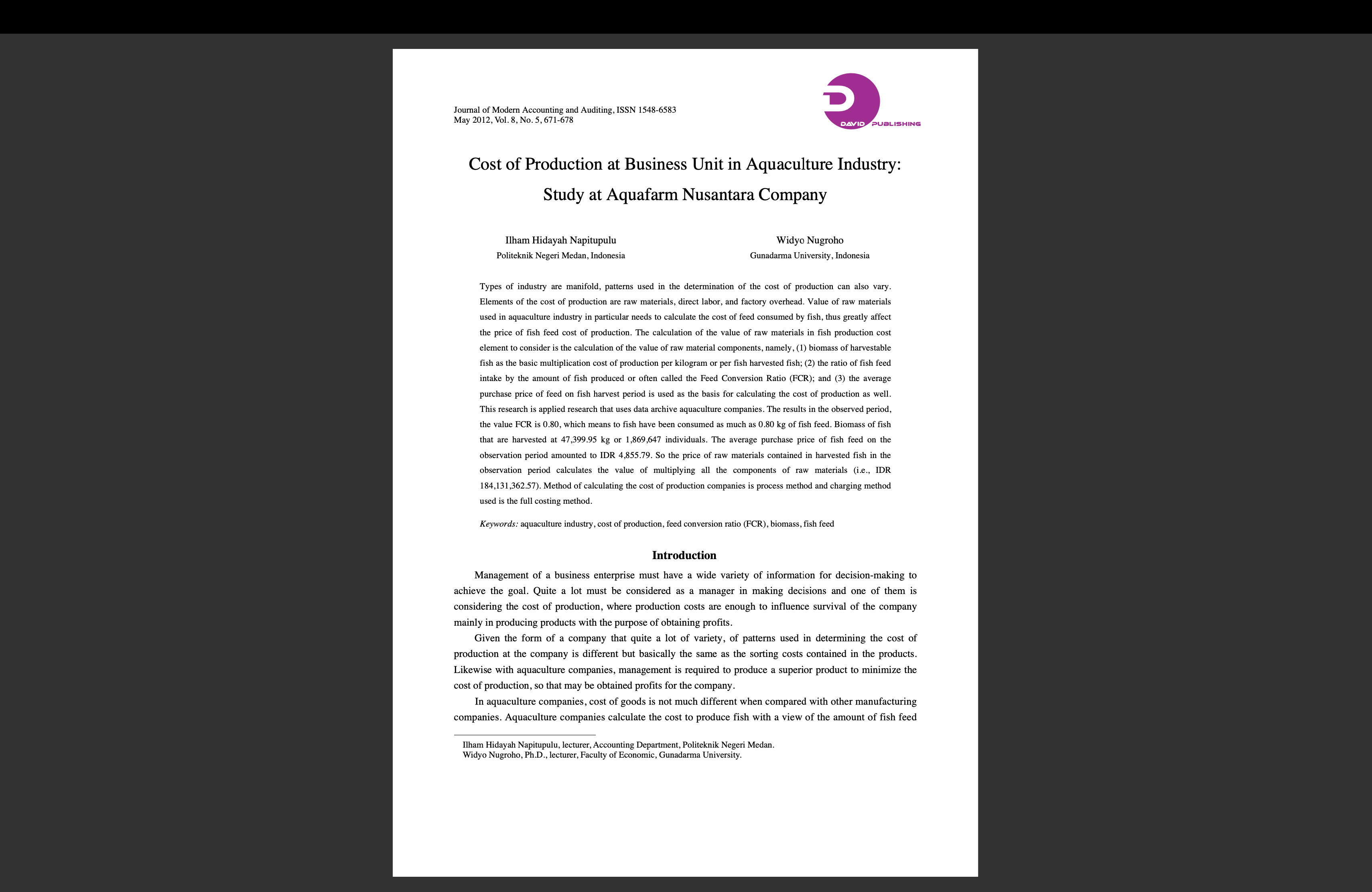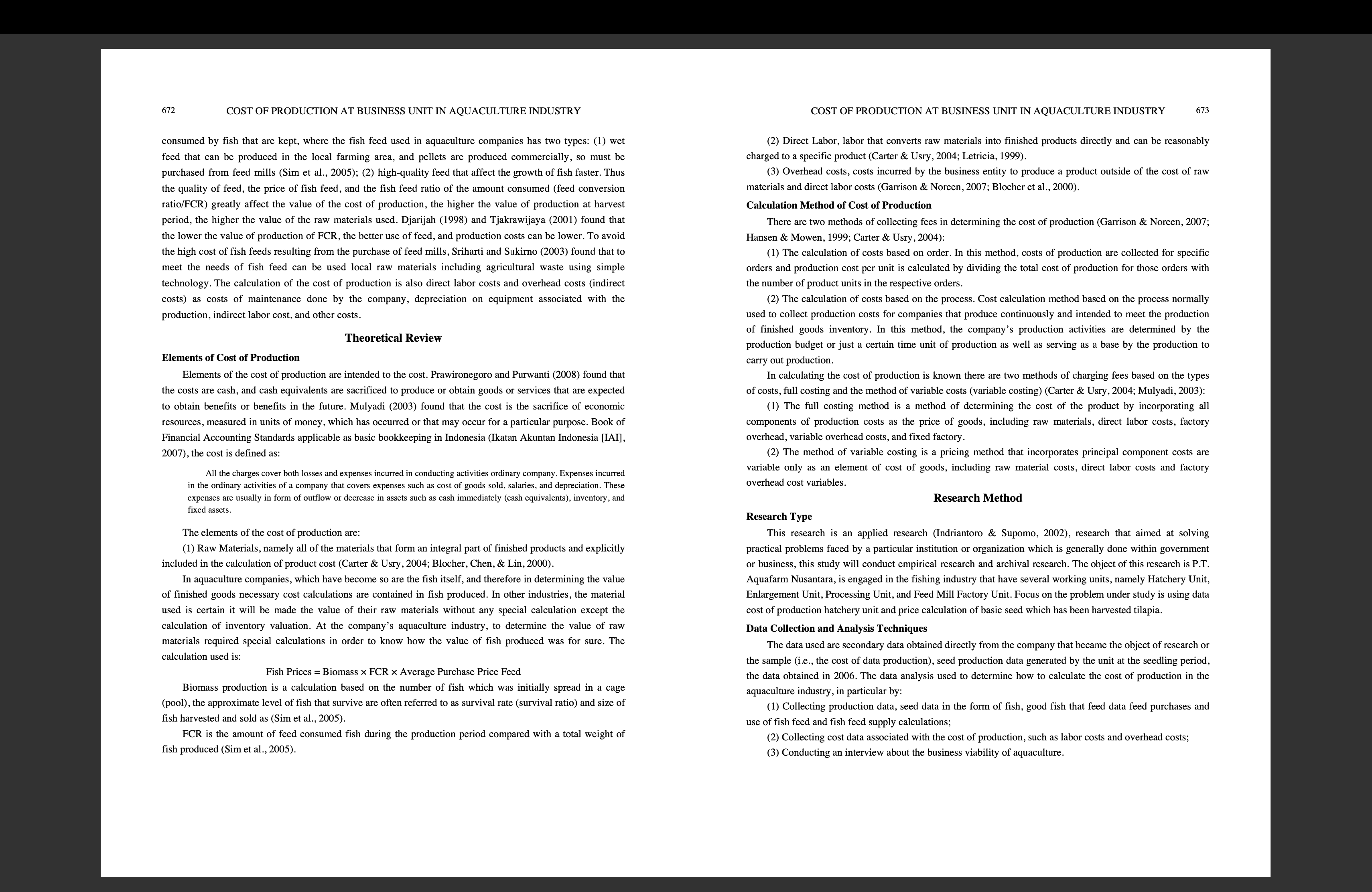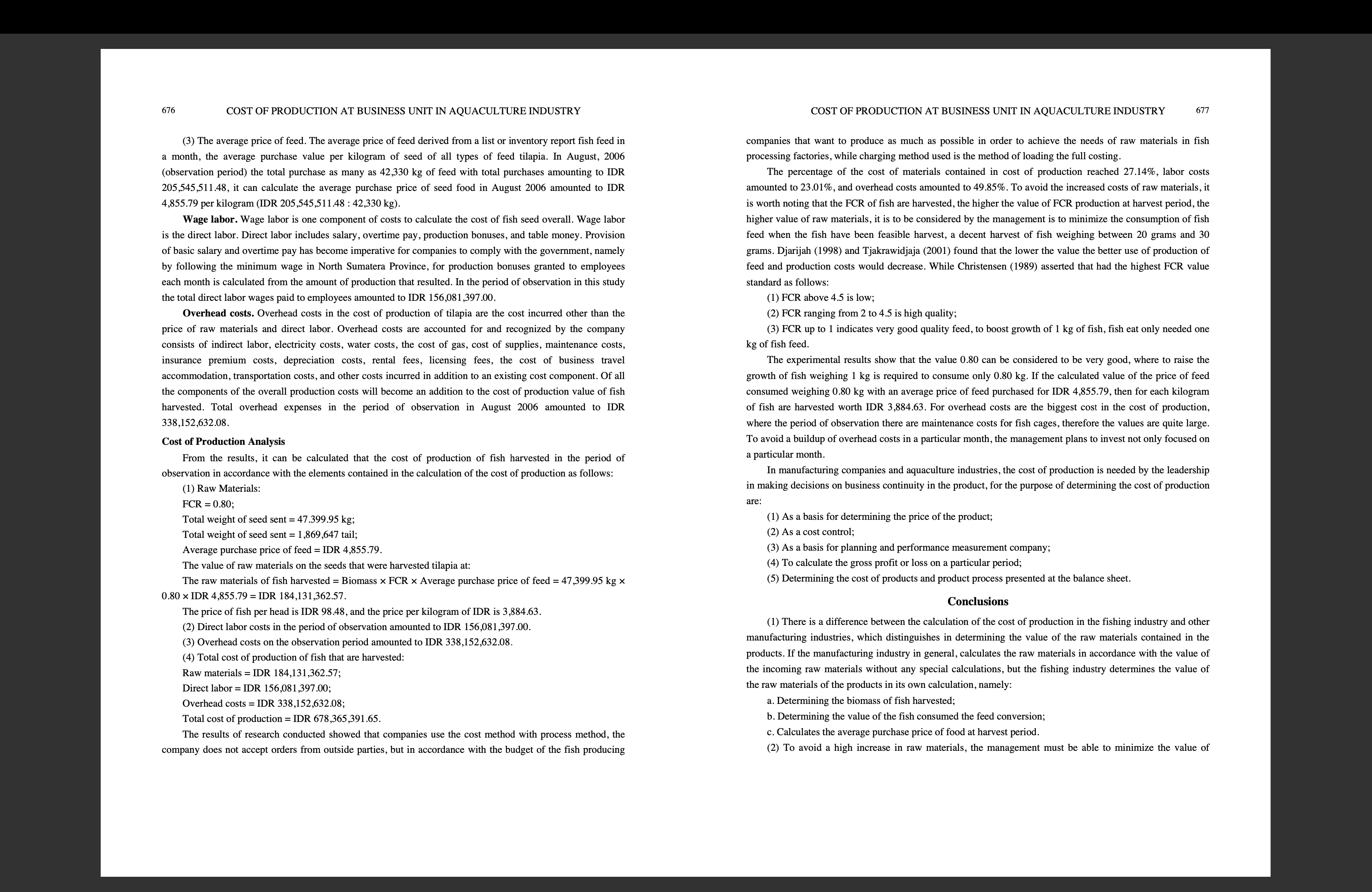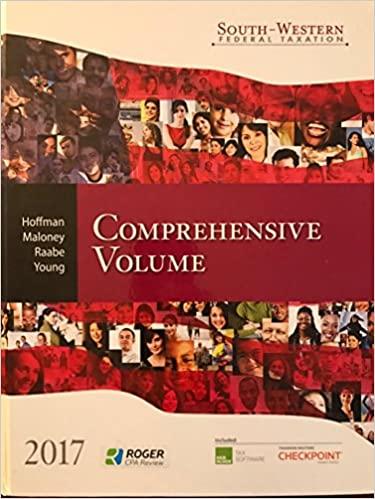Answered step by step
Verified Expert Solution
Question
1 Approved Answer
Journal of Modern Accounting and Auditing, ISSN 1548-6583 May 2012, Vol. 8, No. 5, 671-678 DAVID PUBLISHING Cost of Production at Business Unit in




Journal of Modern Accounting and Auditing, ISSN 1548-6583 May 2012, Vol. 8, No. 5, 671-678 DAVID PUBLISHING Cost of Production at Business Unit in Aquaculture Industry: Study at Aquafarm Nusantara Company Ilham Hidayah Napitupulu Politeknik Negeri Medan, Indonesia Widyo Nugroho Gunadarma University, Indonesia Types of industry are manifold, patterns used in the determination of the cost of production can also vary. Elements of the cost of production are raw materials, direct labor, and factory overhead. Value of raw materials used in aquaculture industry in particular needs to calculate the cost of feed consumed by fish, thus greatly affect the price of fish feed cost of production. The calculation of the value of raw materials in fish production cost element to consider is the calculation of the value of raw material components, namely, (1) biomass of harvestable fish as the basic multiplication cost of production per kilogram or per fish harvested fish; (2) the ratio of fish feed intake by the amount of fish produced or often called the Feed Conversion Ratio (FCR); and (3) the average purchase price of feed on fish harvest period is used as the basis for calculating the cost of production as well. This research is applied research that uses data archive aquaculture companies. The results in the observed period, the value FCR is 0.80, which means to fish have been consumed as much as 0.80 kg of fish feed. Biomass of fish that are harvested at 47,399.95 kg or 1,869,647 individuals. The average purchase price of fish feed on the observation period amounted to IDR 4,855.79. So the price of raw materials contained in harvested fish in the observation period calculates the value of multiplying all the components of raw materials (i.e., IDR 184,131,362.57). Method of calculating the cost of production companies is process method and charging method used is the full costing method. Keywords: aquaculture industry, cost of production, feed conversion ratio (FCR), biomass, fish feed Introduction Management of a business enterprise must have a wide variety of information for decision-making to achieve the goal. Quite a lot must be considered as a manager in making decisions and one of them is considering the cost of production, where production costs are enough to influence survival of the company mainly in producing products with the purpose of obtaining profits. Given the form of a company that quite a lot of variety, of patterns used in determining the cost of production at the company is different but basically the same as the sorting costs contained in the products. Likewise with aquaculture companies, management is required to produce a superior product to minimize the cost of production, so that may be obtained profits for the company. In aquaculture companies, cost of goods is not much different when compared with other manufacturing companies. Aquaculture companies calculate the cost to produce fish with a view of the amount of fish feed Ilham Hidayah Napitupulu, lecturer, Accounting Department, Politeknik Negeri Medan. Widyo Nugroho, Ph.D., lecturer, Faculty of Economic, Gunadarma University. 672 COST OF PRODUCTION AT BUSINESS UNIT IN AQUACULTURE INDUSTRY consumed by fish that are kept, where the fish feed used in aquaculture companies has two types: (1) wet feed that can be produced in the local farming area, and pellets are produced commercially, so must be purchased from feed mills (Sim et al., 2005); (2) high-quality feed that affect the growth of fish faster. Thus the quality of feed, the price of fish feed, and the fish feed ratio of the amount consumed (feed conversion ratio/FCR) greatly affect the value of the cost of production, the higher the value of production at harvest period, the higher the value of the raw materials used. Djarijah (1998) and Tjakrawijaya (2001) found that the lower the value of production of FCR, the better use of feed, and production costs can be lower. To avoid the high cost of fish feeds resulting from the purchase of feed mills, Sriharti and Sukirno (2003) found that to meet the needs of fish feed can be used local raw materials including agricultural waste using simple technology. The calculation of the cost of production is also direct labor costs and overhead costs (indirect costs) as costs of maintenance done by the company, depreciation on equipment associated with the production, indirect labor cost, and other costs. Elements of Cost of Production Theoretical Review Elements of the cost of production are intended to the cost. Prawironegoro and Purwanti (2008) found that the costs are cash, and cash equivalents are sacrificed to produce or obtain goods or services that are expected to obtain benefits or benefits in the future. Mulyadi (2003) found that the cost is the sacrifice of economic resources, measured in units of money, which has occurred or that may occur for a particular purpose. Book of Financial Accounting Standards applicable as basic bookkeeping in Indonesia (Ikatan Akuntan Indonesia [IAI], 2007), the cost is defined as: All the charges cover both losses and expenses incurred in conducting activities ordinary company. Expenses incurred in the ordinary activities of a company that covers expenses such as cost of goods sold, salaries, and depreciation. These expenses are usually in form of outflow or decrease in assets such as cash immediately (cash equivalents), inventory, and fixed assets. The elements of the cost of production are: (1) Raw Materials, namely all of the materials that form an integral part of finished products and explicitly included in the calculation of product cost (Carter & Usry, 2004; Blocher, Chen, & Lin, 2000). In aquaculture companies, which have become so are the fish itself, and therefore in determining the value of finished goods necessary cost calculations are contained in fish produced. In other industries, the material used is certain it will be made the value of their raw materials without any special calculation except the calculation of inventory valuation. At the company's aquaculture industry, to determine the value of raw materials required special calculations in order to know how the value of fish produced was for sure. The calculation used is: Fish Prices Biomass FCR Average Purchase Price Feed Biomass production is a calculation based on the number of fish which was initially spread in a cage (pool), the approximate level of fish that survive are often referred to as survival rate (survival ratio) and size of fish harvested and sold as (Sim et al., 2005). FCR is the amount of feed consumed fish during the production period compared with a total weight of fish produced (Sim et al., 2005). COST OF PRODUCTION AT BUSINESS UNIT IN AQUACULTURE INDUSTRY 673 (2) Direct Labor, labor that converts raw materials into finished products directly and can be reasonably charged to a specific product (Carter & Usry, 2004; Letricia, 1999). (3) Overhead costs, costs incurred by the business entity to produce a product outside of the cost of raw materials and direct labor costs (Garrison & Noreen, 2007; Blocher et al., 2000). Calculation Method of Cost of Production There are two methods of collecting fees in determining the cost of production (Garrison & Noreen, 2007; Hansen & Mowen, 1999; Carter & Usry, 2004): (1) The calculation of costs based on order. In this method, costs of production are collected for specific orders and production cost per unit is calculated by dividing the total cost of production for those orders with the number of product units in the respective orders. (2) The calculation of costs based on the process. Cost calculation method based on the process normally used to collect production costs for companies that produce continuously and intended to meet the production of finished goods inventory. In this method, the company's production activities are determined by the production budget or just a certain time unit of production as well as serving as a base by the production to carry out production. In calculating the cost of production is known there are two methods of charging fees based on the types of costs, full costing and the method of variable costs (variable costing) (Carter & Usry, 2004; Mulyadi, 2003): (1) The full costing method is a method of determining the cost of the product by incorporating all components of production costs as the price of goods, including raw materials, direct labor costs, factory overhead, variable overhead costs, and fixed factory. (2) The method of variable costing is a pricing method that incorporates principal component costs are variable only as an element of cost of goods, including raw material costs, direct labor costs and factory overhead cost variables. Research Type Research Method This research is an applied research (Indriantoro & Supomo, 2002), research that aimed at solving practical problems faced by a particular institution or organization which is generally done within government or business, this study will conduct empirical research and archival research. The object of this research is P.T. Aquafarm Nusantara, is engaged in the fishing industry that have several working units, namely Hatchery Unit, Enlargement Unit, Processing Unit, and Feed Mill Factory Unit. Focus on the problem under study is using data cost of production hatchery unit and price calculation of basic seed which has been harvested tilapia. Data Collection and Analysis Techniques The data used are secondary data obtained directly from the company that became the object of research or the sample (i.e., the cost of data production), seed production data generated by the unit at the seedling period, the data obtained in 2006. The data analysis used to determine how to calculate the cost of production in the aquaculture industry, in particular by: (1) Collecting production data, seed data in the form of fish, good fish that feed data feed purchases and use of fish feed and fish feed supply calculations; (2) Collecting cost data associated with the cost of production, such as labor costs and overhead costs; (3) Conducting an interview about the business viability of aquaculture. 674 COST OF PRODUCTION AT BUSINESS UNIT IN AQUACULTURE INDUSTRY COST OF PRODUCTION AT BUSINESS UNIT IN AQUACULTURE INDUSTRY 675 Inventory Cycle Produced Tilapia Results and Discussion The following cycle is a cycle as a whole tilapia from automation business, which represents the flow of seed production of tilapia. The cycle is shown in Figure 1. Hatchery (Hatchery project) Growth (Grow out project) Factory (Cold storage project) Market (1) Biomass and total of fish harvested tilapia. Biomass is the weight of tilapia harvested in a month which is calculated in kilograms and the amount of seed harvested fish tail. The data obtained in August 2006, counted 1,869,647 harvest tilapia fish weighing a total of 47,399.95 kg, average weight of 25.35 grams of fish, as seen in Table 1. (2) FCR Tilapia. To calculate the value of fish feed conversion (FCR) is required data as shown in Tables 2 and 3. Table 2 Number of Planted Seed Tilapia Description of the picture: Figure 1. Inventory cycle tilapia. (1) Hatchery project: Tilapia hatcheries are managed intensively to produce a superior tilapia, ranging from determining a good parent to a healthy seed must be monitored so as not to cause further delays in production. Hatchery unit is the object of this study, it can be explained again how the cycle of tilapia seed supply is produced until the exit to the growth project, namely, seeds produced from the cultivated parent will be maintained or moved to a place that has been provided, after a time will be moved to growth project. The time required for + three months or achieving proper seed crop size + 20 grams to 30 grams. (2) Growth project: This growth project is a continuation of the cycle of tilapia supplies to be raised during the breeding units + six months or has reached a decent size + average harvest 800 grams, after which it flows the fish will be diverted to the factory project (Cold Storage Project). (3) Factory project: The factory unit is the end of the supply of tilapia that will be processed into products that are expected by the market, namely the Meat Frozen Tilapia. Calculate the Cost of Tilapia That Came Out/Harvest Total supply of fish feed used will be a total inventory value of tilapia, it has become a sure thing, and after a certain time, tilapia stocks will be harvested or will be transferred to growth units. This company obtained the fish feed by purchasing the commercial feed mill. Calculating the value of inventories of harvested tilapia, should know the components that affect the calculation. Calculation of raw materials or of harvested fish stocks. To determine the value of the raw materials contained in harvested fish stocks need to be calculated Nila the following elements: Species Nifi Gtgt Msnf Giftsi Total Table 3 Planted N (Tnm) W (Tnm) BIM (Tnm) Planting Time 11,750 0.77 9 27 18,000 8.00 144 18 44,626 9.43 421 35 3,142,371 4.21 3,216,747 4.29 13,215 13,789 53 53 Seed Production in Growing Species Big size Small size N (bs) W (bs) BIM (bs) ADG UB (%) N (ss) W (ss) BIM (ss) SR (%) Nifi 2,800 38.21 107 1.41 24 0 0 24 Gtgt 14,372 29.29 421 1.22 80 0 0 0 80 Msnf 31,785 25.01 795 0.45 71 12,000 8.00 96 98 Giftsi Total 2,016,606 2,065,563 28.30 28.27 57,068 0.46 58,391 0.46 64 64 666,500 8.12 678,500 8.12 5,412 85 5.508 85 Table 2 shows the number of tilapia seed to be planted or spread over a period of observation and Table 3 shows the description of the total tilapia seed production during the late harvest period by seeding unit. BIM (big size) and BIM (small size) is the amount of production growth totally 63,899 kg. Furthermore, to calculate the value of FCR of fish harvested in the period of data required the use of feed, as shown in Table 4. Table 4 The Use of Feed and FCR The used of feed Table 1 Species NSA (2) NGA 10 (3) 788 (2) NS A-2 (C) 788 (3) PSC-22 Total FCR Biomass Harvest Nifi 134 79 75 14 302 2.82 Species Total tail fish Average weight (gram) Biomass Gtgt 268 268 0.64 Mersi 0 0 Msnf 345 547 91 983 1.10 Gift 8,372 29.32 245.47 Giftsi 8,967 26,741 4,831 8,146 Mernia 26,573 25.21 669.96 Total 9,446 27,635 4,906 8,251 351 351 319 319 49,355 0.79 50,908 0.80 Nifi 2,800 38.22 107.02 White Aurea 2,860 34.43 98.47 Nero GS 0 0 0 Giftsi 1,829,042 25.30 46,279.03 Total 1,869,647 25.35 47,399.95 FCR is the ratio between the amounts of feed used on the amount of fish produced in the harvest period. Sample period of observation in August 2006, the feed used by as many as 50,908 kg, weight of seeds during the growth was estimated 63,900 kg, the FCR of the hatchery project in the month of August 2006 amounted to 50,908 kg 63,899 kg = 0.80 (rounded to two decimal). 676 COST OF PRODUCTION AT BUSINESS UNIT IN AQUACULTURE INDUSTRY (3) The average price of feed. The average price of feed derived from a list or inventory report fish feed in a month, the average purchase value per kilogram of seed of all types of feed tilapia. In August, 2006 (observation period) the total purchase as many as 42,330 kg of feed with total purchases amounting to IDR 205,545,511.48, it can calculate the average purchase price of seed food in August 2006 amounted to IDR 4,855.79 per kilogram (IDR 205,545,511.48: 42,330 kg). Wage labor. Wage labor is one component of costs to calculate the cost of fish seed overall. Wage labor is the direct labor. Direct labor includes salary, overtime pay, production bonuses, and table money. Provision of basic salary and overtime pay has become imperative for companies to comply with the government, namely by following the minimum wage in North Sumatera Province, for production bonuses granted to employees each month is calculated from the amount of production that resulted. In the period of observation in this study the total direct labor wages paid to employees amounted to IDR 156,081,397.00. Overhead costs. Overhead costs in the cost of production of tilapia are the cost incurred other than the price of raw materials and direct labor. Overhead costs are accounted for and recognized by the company consists of indirect labor, electricity costs, water costs, the cost of gas, cost of supplies, maintenance costs, insurance premium costs, depreciation costs, rental fees, licensing fees, the cost of business travel accommodation, transportation costs, and other costs incurred in addition to an existing cost component. Of all the components of the overall production costs will become an addition to the cost of production value of fish harvested. Total overhead expenses in the period of observation in August 2006 amounted to IDR 338,152,632.08. Cost of Production Analysis From the results, it can be calculated that the cost of production of fish harvested in the period of observation in accordance with the elements contained in the calculation of the cost of production as follows: (1) Raw Materials: FCR = 0.80; Total weight of seed sent = 47.399.95 kg; Total weight of seed sent = 1,869,647 tail; Average purchase price of feed = IDR 4,855.79. The value of raw materials on the seeds that were harvested tilapia at: The raw materials of fish harvested = Biomass FCR Average purchase price of feed = 47,399.95 kg x 0.80 IDR 4,855.79 = IDR 184,131,362.57. The price of fish per head is IDR 98.48, and the price per kilogram of IDR is 3,884.63. (2) Direct labor costs in the period of observation amounted to IDR 156,081,397.00. (3) Overhead costs on the observation period amounted to IDR 338,152,632.08. (4) Total cost of production of fish that are harvested: Raw materials = IDR 184,131,362.57; Direct labor IDR 156,081,397.00; Overhead costs = IDR 338,152,632.08; Total cost of production = IDR 678,365,391.65. The results of research conducted showed that companies use the cost method with process method, the company does not accept orders from outside parties, but in accordance with the budget of the fish producing COST OF PRODUCTION AT BUSINESS UNIT IN AQUACULTURE INDUSTRY 677 companies that want to produce as much as possible in order to achieve the needs of raw materials in fish processing factories, while charging method used is the method of loading the full costing. The percentage of the cost of materials contained in cost of production reached 27.14%, labor costs amounted to 23.01%, and overhead costs amounted to 49.85%. To avoid the increased costs of raw materials, it is worth noting that the FCR of fish are harvested, the higher the value of FCR production at harvest period, the higher value of raw materials, it is to be considered by the management is to minimize the consumption of fish feed when the fish have been feasible harvest, a decent harvest of fish weighing between 20 grams and 30 grams. Djarijah (1998) and Tjakrawidjaja (2001) found that the lower the value the better use of production of feed and production costs would decrease. While Christensen (1989) asserted that had the highest FCR value standard as follows: (1) FCR above 4.5 is low; (2) FCR ranging from 2 to 4.5 is high quality; (3) FCR up to 1 indicates very good quality feed, to boost growth of 1 kg of fish, fish eat only needed one kg of fish feed. The experimental results show that the value 0.80 can be considered to be very good, where to raise the growth of fish weighing 1 kg is required to consume only 0.80 kg. If the calculated value of the price of feed consumed weighing 0.80 kg with an average price of feed purchased for IDR 4,855.79, then for each kilogram of fish are harvested worth IDR 3,884.63. For overhead costs are the biggest cost in the cost of production, where the period of observation there are maintenance costs for fish cages, therefore the values are quite large. To avoid a buildup of overhead costs in a particular month, the management plans to invest not only focused on a particular month. In manufacturing companies and aquaculture industries, the cost of production is needed by the leadership in making decisions on business continuity in the product, for the purpose of determining the cost of production are: (1) As a basis for determining the price of the product; (2) As a cost control; (3) As a basis for planning and performance measurement company; (4) To calculate the gross profit or loss on a particular period; (5) Determining the cost of products and product process presented at the balance sheet. Conclusions (1) There is a difference between the calculation of the cost of production in the fishing industry and other manufacturing industries, which distinguishes in determining the value of the raw materials contained in the products. If the manufacturing industry in general, calculates the raw materials in accordance with the value of the incoming raw materials without any special calculations, but the fishing industry determines the value of the raw materials of the products in its own calculation, namely: a. Determining the biomass of fish harvested; b. Determining the value of the fish consumed the feed conversion; c. Calculates the average purchase price of food at harvest period. (2) To avoid a high increase in raw materials, the management must be able to minimize the value of
Step by Step Solution
There are 3 Steps involved in it
Step: 1

Get Instant Access to Expert-Tailored Solutions
See step-by-step solutions with expert insights and AI powered tools for academic success
Step: 2

Step: 3

Ace Your Homework with AI
Get the answers you need in no time with our AI-driven, step-by-step assistance
Get Started


